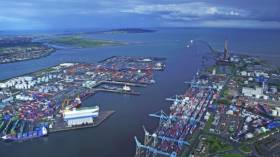Displaying items by tag: Added Capacity: Dublin route
A Ferry Festive Season: Capacity Added On Core Irish Sea Route
#FerryFestive – In this week of Christmas Day, ferries on the Irish Sea are as expected to transport thousands of extra passengers as they prepare to embark making travel plans, writes Jehan Ashmore.
For information on sailings dates and schedules visit the ferry operator websites.
WALES-IRELAND (CENTRAL CORRIDOR)
Holyhead-Dublin Port (Irish Ferries)
Irish Ferries have recently transferred the 1,458-passenger Oscar Wilde ferry on to the premier central corridor Wales-Ireland route of Holyhead-Dublin. The cruiseferry having ended Ireland-France duties of Rosslare-Cherbourg sailings for 2016.
Oscar Wilde will assist the influx of inbound traffic bound for Ireland on the Holyhead-Dublin route. In addition traffic demand will also be taken by regular ferries Ulysses, Epsilon and fast-craft Dublin Swift.
Holyhead-Dublin Port (Stena Line)
Also operating on this key Wales-Ireland route is Stena Line which will too be kept busy on the Holyhead-Dublin Port. The route is run by route partners Stena Adventurer and relative newcomer Stena Superfast X which made a debut in 2015.
Liverpool-Dublin (P&O Ferries)
The longer central corridor route linking Liverpool to Dublin are served by P&O Ferries trio, sisters Norbank and Norbay along with European Endeavour.
Noting P&O Ferries on the Mersey-Liffey service do ‘not’ accommodate ‘foot’ passengers.
Liverpool-Dublin (Seatruck Ferries)
Also operating this route Seatruck which is a dedicated freight operator, have a limited service available for passengers (accompanied by motorhomes and cars). In addition Seatruck operate Heysham-Dublin again providing a motorists-only service.
WALES-IRELAND (SOUTHERN CORRIDOR)
Fishguard-Rosslare (Stena Line)
On the St. Georges Channel crossing, Stena's Fishguard-Rosslare route is operated by Stena Europe.
Pembroke-Rosslare (Irish Ferries)
Also on the Wales-Ireland link, Irish Ferries have Isle of Inishmore running Pembroke-Rosslare.
UK- N.IRELAND (NORTH CHANNEL / IRISH SEA)
For information on UK-Northern Ireland operators (except Irish Ferries) visit their respective websites.
ISLE OF MAN -IRELAND
Douglas-Dublin (IOM Steam-Packet)
As previously reported on Afloat.ie, Isle of Man Steam-Packet’s future plans and referred special festive seasonal Douglas-Dublin sailings, which since coverage however at this stage only apply to post Christmas Day sailings.
On Boxing Day there is a Douglas-Dublin sailing which docks in the Irish capital in the early hours of 27 December. A return leg to the Isle of Man departs the same day at 01.00hrs.





























































